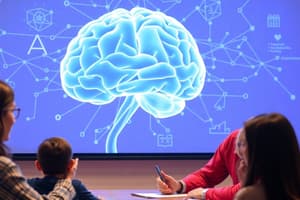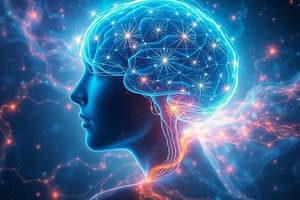Podcast
Questions and Answers
What primarily occurs during anterograde degeneration?
What primarily occurs during anterograde degeneration?
- The entire neuron undergoes apoptosis.
- The distal segment of the axon degenerates. (correct)
- The axon reconnects with the cell body.
- The proximal segment of the axon degenerates.
What is a key indicator of retrograde degeneration?
What is a key indicator of retrograde degeneration?
- Formation of new axonal connections.
- Increase in the size of the cell body.
- Appearances of mass synthesis of proteins.
- Decrease in the size of the cell body. (correct)
What must occur for a regenerated axon to prevent neuronal death?
What must occur for a regenerated axon to prevent neuronal death?
- The axon must increase in length.
- Functional postsynaptic connections must be made. (correct)
- The neuron must undergo transneuronal degeneration.
- The proximal segment must undergo apoptosis.
What characterizes transneuronal degeneration?
What characterizes transneuronal degeneration?
Why is neural regeneration largely nonexistent in the CNS?
Why is neural regeneration largely nonexistent in the CNS?
What does retrograde degeneration specifically refer to?
What does retrograde degeneration specifically refer to?
What is an effect of axotomy on an axon?
What is an effect of axotomy on an axon?
How soon after axotomy can changes in the cell body appear?
How soon after axotomy can changes in the cell body appear?
What is the role of Schwann cells in the PNS after nerve damage?
What is the role of Schwann cells in the PNS after nerve damage?
What prevents regeneration in the CNS following neural damage?
What prevents regeneration in the CNS following neural damage?
Under which condition will peripheral axons regenerate effectively?
Under which condition will peripheral axons regenerate effectively?
What process occurs when an area of the cortex becomes vacant after neural degeneration?
What process occurs when an area of the cortex becomes vacant after neural degeneration?
Which mechanism of neural reorganization involves the rapid removal of inhibition from excitatory neurons?
Which mechanism of neural reorganization involves the rapid removal of inhibition from excitatory neurons?
What characterizes collateral sprouting?
What characterizes collateral sprouting?
What is the main consequence of a large chunk of nerve being damaged in the PNS?
What is the main consequence of a large chunk of nerve being damaged in the PNS?
What happens to the visual cortex in blind individuals over time?
What happens to the visual cortex in blind individuals over time?
How quickly can regrowth of peripheral axons begin after damage?
How quickly can regrowth of peripheral axons begin after damage?
What role do astrocytes play in the CNS after axonal injury?
What role do astrocytes play in the CNS after axonal injury?
What occurs to the distal segment of the axon during anterograde degeneration?
What occurs to the distal segment of the axon during anterograde degeneration?
What indicates the occurrence of retrograde degeneration in a neuron?
What indicates the occurrence of retrograde degeneration in a neuron?
What happens during retrograde regeneration after an axotomy?
What happens during retrograde regeneration after an axotomy?
During transneuronal degeneration, which type of neuron is affected during retrograde transneuronal degeneration?
During transneuronal degeneration, which type of neuron is affected during retrograde transneuronal degeneration?
Which of the following best characterizes why regeneration is largely absent in the CNS?
Which of the following best characterizes why regeneration is largely absent in the CNS?
Which outcome is expected if the size of the cell body increases after axotomy?
Which outcome is expected if the size of the cell body increases after axotomy?
What is the primary effect of axotomy on the neural structure?
What is the primary effect of axotomy on the neural structure?
What type of degeneration spreads to postsynaptic neurons during transneuronal degeneration?
What type of degeneration spreads to postsynaptic neurons during transneuronal degeneration?
What happens to the axons following the severance of a nerve when there is a large gap between the proximal and distal segments?
What happens to the axons following the severance of a nerve when there is a large gap between the proximal and distal segments?
Which cells in the CNS actively block axonal regeneration?
Which cells in the CNS actively block axonal regeneration?
What is the role of neurotrophic factors released by Schwann cells in the PNS?
What is the role of neurotrophic factors released by Schwann cells in the PNS?
Which mechanism of neural reorganization occurs quickly and involves the removal of inhibition?
Which mechanism of neural reorganization occurs quickly and involves the removal of inhibition?
What typically fills a cortical area that has become vacant after motor neuron damage in rats?
What typically fills a cortical area that has become vacant after motor neuron damage in rats?
What occurs in the initial 2-3 days following nerve damage in the PNS?
What occurs in the initial 2-3 days following nerve damage in the PNS?
What is an outcome of the axonal regeneration process when the myelin sheath is intact?
What is an outcome of the axonal regeneration process when the myelin sheath is intact?
What happens during collateral sprouting in the nervous system?
What happens during collateral sprouting in the nervous system?
Which of the following is true regarding the regeneration in the PNS?
Which of the following is true regarding the regeneration in the PNS?
How does the auditory and somatosensory cortex change in blind individuals?
How does the auditory and somatosensory cortex change in blind individuals?
Flashcards are hidden until you start studying
Study Notes
Neural Degradation
- Damage to the nervous system can lead to neural degradation, observed through axotomy, which is the cutting of axons.
- Two main types of neural degeneration:
- Anterograde degeneration: Occurs in the distal segment of the axon; faster process due to disconnection from the cell body leading to swelling and breakdown within days.
- Retrograde degeneration: Involves the proximal segment; can result in either degeneration or potential reconnection with the distal segment, indicated by changes in the cell body within 2-3 days.
- Decreased cell body size suggests retrograde degeneration (apoptosis or necrosis).
- Increased cell body size indicates retrograde regeneration linked to protein synthesis vital for axon repair.
- For effective regeneration, the regenerated axon must establish functional postsynaptic connections. Failure to do so results in neuronal death.
- Transneuronal degeneration: Spreads to neighboring neurons:
- Anterograde transneuronal degeneration affects postsynaptic neurons.
- Retrograde transneuronal degeneration impacts presynaptic neurons.
Neural Regeneration
- Neural regeneration follows axotomy when severed axons attempt to repair (retrograde regeneration).
- In the central nervous system (CNS), regeneration is nearly non-existent due to two primary reasons:
- Differences in characteristics between CNS and peripheral nervous system (PNS) neurons; CNS neurons are inherently incapable of regeneration, while PNS neurons are programmed for regeneration.
- Environmental factors in the CNS do not support regeneration, whereas the PNS environment encourages it.
- In the PNS, Schwann cells play a critical role in promoting regeneration. They clear debris, release neurotrophic factors, and guide axonal growth through cell adhesion molecules.
- Contrarily, oligodendrocytes and astrocytes in the CNS inhibit regeneration by not clearing debris, blocking axonal growth, and forming glial scars which act as barriers to regeneration.
- Regrowth after PNS damage typically starts within 2-3 days, with outcomes depending on the myelin sheath's integrity:
- Intact myelin sheath: Regeneration occurs, growing towards correct targets at a rate of a few millimeters per day.
- Minor separation of axonal segments: Growth combs may reach incorrect myelin sheaths.
- Significant distance between severed ends: Regeneration fails, leading to neuron death and tangled axon tips.
Neural Reorganization
- Neural reorganization leads to changes without growth or damage, redistributing cortical representation as seen in studies of the motor cortex.
- Following axotomy of motor neurons in rats, the affected cortical area becomes vacant and eventually is innervated by surrounding functional areas, demonstrating competition for cortical space.
- In blind individuals, the visual cortex, lacking visual input, becomes occupied by auditory and somatosensory cortices, enhancing their skills in these areas compared to sighted peers.
- Two mechanisms of neural reorganization:
- Disinhibition: Removal of inhibition from an excitatory neuron by an inhibitory neuron, allowing the excitatory neuron to activate freely; a short-term and quick process.
- Collateral sprouting: Formation of new synaptic connections when a postsynaptic area becomes vacant, enabling synapse formation from presynaptic neuron terminals or nodes of Ranvier; this is a long-term process that expands the cortical area of the neuron.
Neural Degradation
- Damage to the nervous system can lead to neural degradation, observed through axotomy, which is the cutting of axons.
- Two main types of neural degeneration:
- Anterograde degeneration: Occurs in the distal segment of the axon; faster process due to disconnection from the cell body leading to swelling and breakdown within days.
- Retrograde degeneration: Involves the proximal segment; can result in either degeneration or potential reconnection with the distal segment, indicated by changes in the cell body within 2-3 days.
- Decreased cell body size suggests retrograde degeneration (apoptosis or necrosis).
- Increased cell body size indicates retrograde regeneration linked to protein synthesis vital for axon repair.
- For effective regeneration, the regenerated axon must establish functional postsynaptic connections. Failure to do so results in neuronal death.
- Transneuronal degeneration: Spreads to neighboring neurons:
- Anterograde transneuronal degeneration affects postsynaptic neurons.
- Retrograde transneuronal degeneration impacts presynaptic neurons.
Neural Regeneration
- Neural regeneration follows axotomy when severed axons attempt to repair (retrograde regeneration).
- In the central nervous system (CNS), regeneration is nearly non-existent due to two primary reasons:
- Differences in characteristics between CNS and peripheral nervous system (PNS) neurons; CNS neurons are inherently incapable of regeneration, while PNS neurons are programmed for regeneration.
- Environmental factors in the CNS do not support regeneration, whereas the PNS environment encourages it.
- In the PNS, Schwann cells play a critical role in promoting regeneration. They clear debris, release neurotrophic factors, and guide axonal growth through cell adhesion molecules.
- Contrarily, oligodendrocytes and astrocytes in the CNS inhibit regeneration by not clearing debris, blocking axonal growth, and forming glial scars which act as barriers to regeneration.
- Regrowth after PNS damage typically starts within 2-3 days, with outcomes depending on the myelin sheath's integrity:
- Intact myelin sheath: Regeneration occurs, growing towards correct targets at a rate of a few millimeters per day.
- Minor separation of axonal segments: Growth combs may reach incorrect myelin sheaths.
- Significant distance between severed ends: Regeneration fails, leading to neuron death and tangled axon tips.
Neural Reorganization
- Neural reorganization leads to changes without growth or damage, redistributing cortical representation as seen in studies of the motor cortex.
- Following axotomy of motor neurons in rats, the affected cortical area becomes vacant and eventually is innervated by surrounding functional areas, demonstrating competition for cortical space.
- In blind individuals, the visual cortex, lacking visual input, becomes occupied by auditory and somatosensory cortices, enhancing their skills in these areas compared to sighted peers.
- Two mechanisms of neural reorganization:
- Disinhibition: Removal of inhibition from an excitatory neuron by an inhibitory neuron, allowing the excitatory neuron to activate freely; a short-term and quick process.
- Collateral sprouting: Formation of new synaptic connections when a postsynaptic area becomes vacant, enabling synapse formation from presynaptic neuron terminals or nodes of Ranvier; this is a long-term process that expands the cortical area of the neuron.
Studying That Suits You
Use AI to generate personalized quizzes and flashcards to suit your learning preferences.





